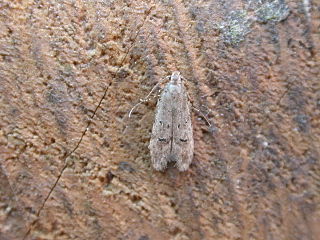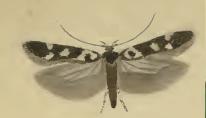
The scalloped hazel is a moth of the family Geometridae. The species was first described by Carl Alexander Clerck in 1759.

The willow beauty is a moth of the family Geometridae. It is a common species of Europe and adjacent regions. While it is found widely throughout Scandinavian countries, which have a maritime climate, it is absent from parts of the former USSR which are at the same latitude but have a more continental climate.

Furcula furcula, the sallow kitten, is a moth from the family Notodontidae. It was first described by the Swedish entomologist Carl Alexander Clerck in 1759 from a specimen found in Sweden.

Anacampsis is a worldwide genus of moth with most found in the nearctic and neotropical regions. It is in the family Gelechiidae. The larvae feed on a range of deciduous trees and shrubs in a rolled or folded leaf, or spun shoot.

The March dagger moth is a moth of the subfamily Chimabachinae. It is found in Europe and was first described by Michael Denis & Ignaz Schiffermüller in 1775.

Athrips mouffetella is a moth of the family Gelechiidae. It is found from central and northern Europe to the Ural Mountains, Siberia and the Russian Far East. It has also been recorded from North America.

Recurvaria leucatella is a moth of the family Gelechiidae. It is found in most of Europe, Turkey, Central Asia and the Caucasus.

Batrachedra praeangusta is a moth of the family Batrachedridae which is native to Europe. It is also found in North America. It was first described by Adrian Haworth in 1828 from the type specimen found in England. The foodplants of the larvae are poplars and willows.

Chrysoesthia sexguttella, the orache leafminer moth, is a moth in the family Gelechiidae. It is found in all of Europe, east to southern Siberia, as well as the north-eastern parts of North America, where it might be an introduced species.

Epinotia nisella is a moth of the family Tortricidae which is found in the Palearctic, Europe and North America. It was first described by Carl Alexander Clerck in 1759.

Teleiodes vulgella is a moth of the family Gelechiidae. It is known from most of Europe, east to the southern Ural and the Volga region.

Agonopterix conterminella is a moth of the family Depressariidae which is found in Asia, Europe and North America. It was described by Philipp Christoph Zeller in 1839 from a specimen found in Augsburg, Germany. The larvae feed on the terminal shoots of willows.

Caryocolum vicinella is a moth of the family Gelechiidae. It is found in most of Europe, eastwards to the southern Ural.

Pseudotelphusa paripunctella is a moth of the family Gelechiidae. It is found from most of Europe to Siberia and the Caucasus.

Anacampsis temerella is a moth of the family Gelechiidae, found in most of Europe, except Belgium, Switzerland, the Iberian Peninsula and the Balkan Peninsula.

Carpatolechia notatella, the sallow-leaf groundling, is a moth of the family Gelechiidae. It is found in most of Europe and Turkey.

Metzneria metzneriella is a moth of the family Gelechiidae. It is widely distributed throughout Europe, as well as Turkey and southern Siberia. The habitat consists of dry pastures and calcareous soils.

Teleiodes luculella, the crescent groundling, is a moth of the family Gelechiidae. It is found from Europe to the southern Ural and Transcaucasia. The habitat consists of woodlands, including oak woodlands.

Gelechia sororculella, the dark-striped groundling, is a moth of the family Gelechiidae. It is widely distributed from Europe, throughout Siberia to the Russian Far East.

Epinotia subocellana is a species of moth of the family Tortricidae. It is found in Asia and Europe and was first described by Edward Donovan in 1806.




















